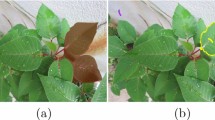Abstract
The image foresting transform (IFT) can divide an image into object and background, each represented by one optimum-path forest rooted at internal and external markers selected by the user. We have considerably reduced the number of markers (user involvement) by separating object enhancement from its extraction. However, the user had no guidance about effective marker location during extraction, losing segmentation control. Now, we pre-segment the image automatically into a few regions. The regions inside the object are selected and merged from internal markers. Regions with object and background pixels are further divided by IFT. This provides more user control with minimum involvement, as validated on two public datasets.
Preview
Unable to display preview. Download preview PDF.
Similar content being viewed by others
References
Falcão, A., Udupa, J., Miyazawa, F.: An ultra-fast user-steered image segmentation paradigm: Live-wire-on-the-fly. IEEE Trans. on Medical Imaging 19, 55–62 (2000)
Spina, T., Montoya-Zegarra, J., Falcão, A., Miranda, P.: Fast interactive segmentation of natural images using the image foresting transform. In: DSP (International Conference on Digital Signal Processing), Santorini, Greece. IEEE, Los Alamitos (2009) (accepted for publication)
Rother, C., Kolmogorov, V., Blake, A.: “grabcut”: interactive foreground extraction using iterated graph cuts. ACM Transactions on Graphics 23, 309–314 (2004)
Protiere, A., Sapiro, G.: Interactive image segmentation via adaptive weighted distances. IEEE Transactions on Image Processing 16, 1046–1057 (2007)
Vicente, S., Kolmogorov, V., Rother, C.: Graph cut based image segmentation with connectivity priors. In: IEEE Proc. of CVPR, Anchorage, Alaska, pp. 1–8 (2008)
Beucher, S., Meyer, F.: The morphological approach to segmentation: The watershed transformation. In: Mathematical Morphology in Image Processing, pp. 433–481. M. Dekker, New York (1993)
Lotufo, R., Falcão, A.: The ordered queue and the optimality of the watershed approaches. In: Mathematical Morphology and its Applications to Image and Signal Processing, vol. 18, pp. 341–350. Kluwer, Dordrecht (2000)
Falcão, A., Stolfi, J., Lotufo, R.: The image foresting transform: Theory, algorithms, and applications. IEEE Trans. on Pattern Analysis and Machine Intelligence 26, 19–29 (2004)
Portilla, J., Simoncelli, E.P.: A parametric texture model based on joint statistics of complex wavelet coefficients. Intl. Journal of Computer Vision 40, 49–70 (2000)
Meyer, F.: Levelings, image simplification filters for segmentation. Journal of Mathematical Imaging and Vision 20, 59–72 (2004)
Papa, J.P., Falcão, A.X., Suzuki, C.T.N., Mascarenhas, N.D.A.: A discrete approach for supervised pattern recognition. In: Brimkov, V.E., Barneva, R.P., Hauptman, H.A. (eds.) IWCIA 2008. LNCS, vol. 4958, pp. 136–147. Springer, Heidelberg (2008)
Salembier, P., Oliveras, A., Guarrido, L.: Antiextensive connected operators for image and sequence processing. IEEE Transactions on Image Processing 7, 555–570 (1998)
van Rijsbergen, C.: Information retrieval, 2nd edn. Wiley Interscience, London (1979)
Author information
Authors and Affiliations
Editor information
Editors and Affiliations
Rights and permissions
Copyright information
© 2009 Springer-Verlag Berlin Heidelberg
About this paper
Cite this paper
Spina, T.V., Montoya-Zegarra, J.A., Miranda, P.A.V., Falcão, A.X. (2009). Improving User Control with Minimum Involvement in User-Guided Segmentation by Image Foresting Transform. In: Jiang, X., Petkov, N. (eds) Computer Analysis of Images and Patterns. CAIP 2009. Lecture Notes in Computer Science, vol 5702. Springer, Berlin, Heidelberg. https://doi.org/10.1007/978-3-642-03767-2_118
Download citation
DOI: https://doi.org/10.1007/978-3-642-03767-2_118
Publisher Name: Springer, Berlin, Heidelberg
Print ISBN: 978-3-642-03766-5
Online ISBN: 978-3-642-03767-2
eBook Packages: Computer ScienceComputer Science (R0)




